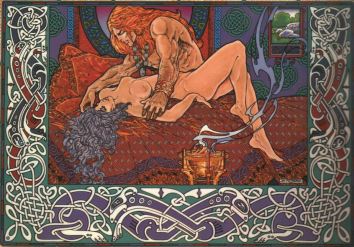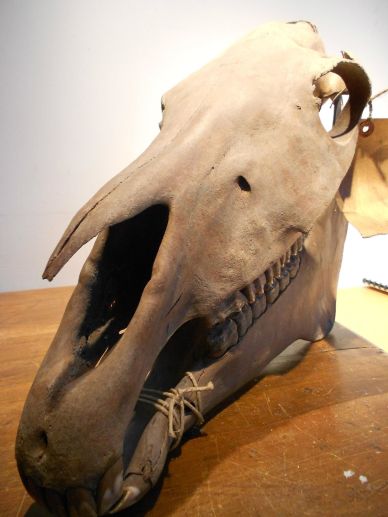Sometimes I like to go to a particular corner of the Ulster Museum, where the Iron Age tack is displayed, and just sit there . This, on writing, looks a lot sadder than it actually is. It’s not a very ‘sexy’ área of the museum unless you are into later prehistory, and many walk right past it on their way to the mummy or the big flashy Viking swords. Don’t get me wrong, those displays are equally beautiful and important, but there’s something about the grace of the relief work on the Lisnacrogher sword scabbard, and the first hints of the ‘Claddagh’ ring design on the 1c type Y-pieces shown in conjunction with small pony bits that makes my heart go pittipatter. For most however, unless you have a certain proclivity for swirly martial things, it’s a bit of a forgotten corner.
The objects are subtle in their beauty, with something of an edge to them – swords, equestrian equipment, brutally beautiful jewellery all suggest wearers who were culturally charming, slightly vain and latently lethal. Growing up in the height of the Troubles, I knew many ‘godfathers’ who answered a similar description. Their hospitality and warmth was deceiving to those who weren’t ‘in the know’ as to who, or perhaps most importantly, what, they were. I think as I have gotten older I have realised that the parts of Northern Ireland I lived in were the places where hints of the Iron Age and the transition period from pagan Ireland to the early historic period were still kept alive by tradition and social mores
 People forgot what objects do when technology gets rolling, and then make stuff up about them, reinventing a story the way they want it to be for their time, their place, or their socio-political agenda. Swords only gain mythos with such veneers of false memory; a sword has A History and a Destiny (and yep, those capital letters are needed for the
People forgot what objects do when technology gets rolling, and then make stuff up about them, reinventing a story the way they want it to be for their time, their place, or their socio-political agenda. Swords only gain mythos with such veneers of false memory; a sword has A History and a Destiny (and yep, those capital letters are needed for the

cinematic tone I’m using while writing!). People get all excited about swords because they think of Cu Chullain and warriors and Jim Fitzpatrick paintings, and truthfully, I’m cool with that. If the war lords of two thousand years were allowed to come back, living and breathing for one day, I imagine that they’d love to be shown with swords in hand, pumped six packs, writhing on furs with goddesses of unearthly beauty and flattening the enemy. Reality was duller, harder, lacking glory and focussed on survival as life always is; the Iron Age, in Ireland anyway, was thuglyfe, where revenge scuffles got magnified into legend. Not much separates the Táin from Tupac, only the span of the years.
But the horse stuff of the Iron Age -that’s a bit different. People forgot the specialised uses because cars, and engines took over, and horses are seen as pets of the privileged and not relevant to this brave new world. I grew up around horses and ponies, some of them not the sort you ever would place young Tamsin or Victoria on. Of maybe you would, just for schadenfreude, if you had a wicked streak in your Communist ethos. Those kinds of ponies were education on four legs. Some were young and dumb, some in horsie PTSD states from past experiences, some just plain mean. But they were the best teachers on the planet as to how, if one thing doesn’t work to make them accomplices, something else will. There’s a bit for every horse, they say. Our ancestors were no different n their understanding of that. If you want a willing horse, you need to find all the buttons that make it work for both of you.
As I’ve worked on this research, I find it pleasant to think of the golden ‘Celtic’ (cough cough) Age of Heroes being covered in stable muck. The people are more real, just like you and me. Living with horses isn’t all about galloping around – it’s the discipline to put your animal’s welfare first before your own comfort. Cleaning it, feeding and watering after a day’s work, even when you ache. Not very glamorous, but a nice life , enhanced by soft pony muzzles looking for treats and affection, with the calm of a good days work. But an entire re-imagining of the reality of the ‘heroic age’ of 2000 years ago started as soon as young monks with quills moved into the great ecclesiastic centres which spread across Ireland from the 5th and 6th centuries AD. No mud or chapped hands or manure on the carpet was ever allowed in that fantasy world. Absence of glorious distractions such as cat memes and live streaming presumably allowed them to write their re-imagining of folk tales and vague memories, making them into 2 AD Fast Too Furious. And so the great Irish myths were most likely born. Jim Mallory gives the academic talking of that talk in Aspects of the Tain. You’ll get copies from the Navan Centre, in Armagh.
So, while swords and pointy things are all kinds of archaeological and folkloric sexy, bridles and bits got forgotten, just like the horses who once wore them. I read a story once, ages ago, a Native American legend, of the old Coyote Woman who gathers useless bones together from the desert and takes them back to her cave. She lays them out as if on a lab  table and sings them back into muscle and heartbeat and breath until they jump up from the sandy floor and run off into the desert again. Now, metaphorically that’s pretty much what archaeologists do to some extent. Let me tell you, it’s a strange thing when working with bits and Y-pieces, being able to actually feel how those animals behaved when riding out 2000 years ago. Feeling the use on the bits, you’ll know who leaned on the bit too much, who was a nice forward ride. Don’t ever let anyone tell you memory is an abstract thing and intangible. It’s real, for those who choose to look at it. Because what we use, especially the things we use over and over again, display so much about us.
table and sings them back into muscle and heartbeat and breath until they jump up from the sandy floor and run off into the desert again. Now, metaphorically that’s pretty much what archaeologists do to some extent. Let me tell you, it’s a strange thing when working with bits and Y-pieces, being able to actually feel how those animals behaved when riding out 2000 years ago. Feeling the use on the bits, you’ll know who leaned on the bit too much, who was a nice forward ride. Don’t ever let anyone tell you memory is an abstract thing and intangible. It’s real, for those who choose to look at it. Because what we use, especially the things we use over and over again, display so much about us.
A horse, of course is not just a horse – it carries a culture on its back. It’s a means of travel, a way of life, requiring a particular landscape and maintenance. The memory held of those bits also tell stories about the people who made the tack, from the people stoking up the gleaming furnaces for the casting in bronze, to the riders themselves and how they lived. You know those science fiction dystopian films, where a hologram flickers into life by accident in response to some accidental traveller in the ruins of a past culture? And the hologram tells of that culture’s peril? It’s a bit like that, working on this research.
When I sit in the dim lit corner of the museum, needing peace and quiet, I know what those pieces on display are used for, how they work. They told their stories, and continue to do so, them and their counterparts across Europe. They don’t sit there, unremembered or rewritten. The ponies stayed truthful as animals do, and told about the world, 2000 years ago, from their point of view. And by them answering the questions so well, they are now part of my memory of the crazy and sometimes traumatic undergraduate years and MSc times. They are now part of my own history, my memory. Nothing got forgotten after all, only delayed a wee while (and wait til you see some of the answers – but maybe more importantly, some of the new questions!).
